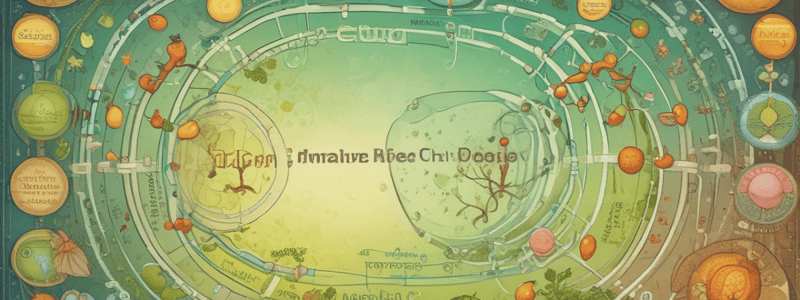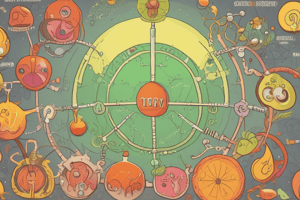Podcast
Questions and Answers
What is gluconeogenesis?
What is gluconeogenesis?
- The breakdown of glucose
- The making of glucose from pyruvate (correct)
- The conversion of glucose to lactate
- The making of glycogen
Which molecule combines with a four-carbon chain called oxaloacetate in the citric acid cycle?
Which molecule combines with a four-carbon chain called oxaloacetate in the citric acid cycle?
- Citrate
- Fumarate
- Acetyl-CoA (correct)
- Malate
What type of reaction is the link reaction?
What type of reaction is the link reaction?
- Oxidative decarboxylation (correct)
- Reductive carboxylation
- Isomerisation
- Hydrolysis
What is generated in Step 3 of the TCA cycle?
What is generated in Step 3 of the TCA cycle?
Which enzyme is involved in step 5 of the TCA cycle?
Which enzyme is involved in step 5 of the TCA cycle?
What is regenerated in step 6 of the TCA cycle?
What is regenerated in step 6 of the TCA cycle?
Which molecule is involved in the preparation step of the citric acid cycle?
Which molecule is involved in the preparation step of the citric acid cycle?
Which of the following is a product of the citric acid cycle?
Which of the following is a product of the citric acid cycle?
What happens in step 8 of the TCA cycle?
What happens in step 8 of the TCA cycle?
Which term describes the removal of electrons from carbon?
Which term describes the removal of electrons from carbon?
Flashcards are hidden until you start studying
Study Notes
Citric Acid Cycle
- Gluconeogenesis is the process of generating glucose from pyruvate.
- Glycogen synthesis is the process of generating glycogen.
- Citric acid cycle generates 150 kJ/mole of ATP, which can occur in the presence or absence of oxygen.
Preparation Step (Step 0)
- Breaks down a 3-carbon chain, releasing 1 molecule of carbon dioxide, to generate a 2-carbon chain that enters the cycle.
- The 2-carbon chain combines with a 4-carbon chain called oxaloacetate to form citric acid, creating a 6-carbon molecule.
TCA Cycle: 8 Steps + Preparation
- Step 1: Pyruvate is converted to Acetyl-CoA, releasing CO₂ and generating NADH.
- Step 2: Citrate is formed from Acetyl-CoA.
- Step 3: Isocitrate is formed, generating NADH.
- Step 4: α-Ketoglutarate is formed, releasing CO₂ and generating NADH.
- Step 5: GTP is generated through substrate-level phosphorylation, converting GDP + Pi to GTP.
- Step 6: The enzyme oxidoreductase generates more NADH and FADH2.
- Step 7: Involves a redox reaction and a ligase reaction, making or breaking double carbon bonds.
- Step 8: Oxaloacetate is regenerated, completing the cycle.
Key Molecules and Processes
- NADH and FADH2 are generated in the citric acid cycle, which will be used to generate more ATP later.
- Redox reactions, such as oxidative decarboxylation, occur throughout the cycle.
- The citric acid cycle is a critical step in cellular respiration, breaking down carbon chains and generating energy.
Studying That Suits You
Use AI to generate personalized quizzes and flashcards to suit your learning preferences.




